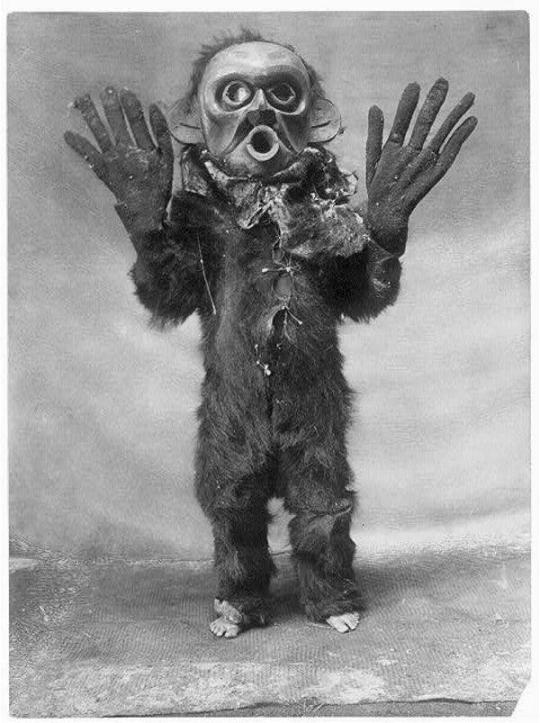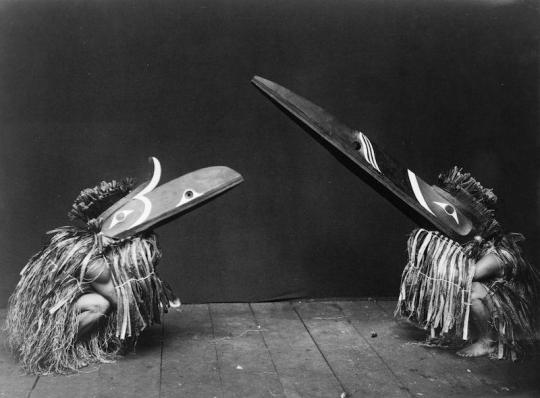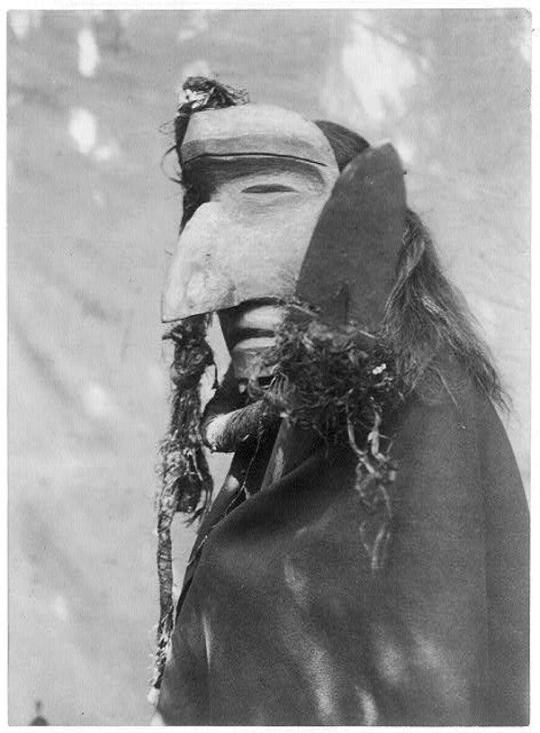#kwakwaka’wakw
Explore tagged Tumblr posts
Text




Sea Monster with Sea Lion Helper
Bob Whonnock
45 notes
·
View notes
Text
For #InternationalBeaverDay here are two wooden beaver effigies spotted at the Smithsonian National Museum of the American Indian:

object name: beaver figure culture: Kwakwaka’wakw (Kwakiutl) place of origin: British Columbia date: c. 1900 materials: wood, paint dimensions: 16.5 cm. I.; 15 w.; 28 h. NMAI catalogue # 21/1355

object name: beaver bowl culture: Tlingit place of origin: Klukwan, Alaska date: c. 1850 materials: wood dimensions: 33 cm. I.; 16 w.; 13 h. NMAI catalogue # 23/8417
#International Beaver Day#animal holiday#beaver#rodents#Native American art#First Nations art#Indigenous art#19th century art#20th century art#effigy#figure#bowl#sculpture#woodwork#carving#Tlingit#Kwakwaka’wakw#Kwakiutl#British Columbia#Alaska#Smithsonian National Museum of the American Indian#museum visit#animals in art
110 notes
·
View notes
Text


Killer Whale Pod of Many Nations (2006) by Odin Lonning (Tlingit) carved cedar with acrylic
The seven-foot-long red cedar carving of five killer whales in five Northwest Coast Native art styles is a tribute to endangered orcas and Coastal tribes from Puget Sound to Alaska.
The Tlingit whale denotes how a crest originates in the story of Natsiclané, or Creation of the Killer Whale. The Haida whale embodies two stories about the Raven-Finned Killer Whale and the adventures of Nanasimgit and His Wife. The Nuu-chah-nulth whale signifies the timeless wolf-killer whale connection in their culture and commemorates Tsux’iit (Luna).
The Kwakwaka’wakw whale celebrates the triumphant reunion of Keetla (Springer) with her pod in Namgis First Nation territory in British Columbia. A vocal delegation of “Springer’s Peeps” cheered enthusiastically for this whale, which shows Springer spyhopping. The Coast Salish whale pays homage to the Indigenous peoples and Southern Resident orcas of the Salish Sea.
Killer Whale Pod of Many Nations: “Carving for a Greater Cause” by Ann Stateler, for WHULJ, The Newsletter of the Puget Sound Chapter of the American Cetacean Society, Winter 2007 (PDF here)
This piece was made possible by a Native Arts grant from the Potlatch Fund.
On display at the Seattle Aquarium, in the Puget Sound Orcas Family Activity Center Photograph 1 by Scott Beale / Laughing Squid Photograph 2 by Bryan Lor / Adventures of BL
#kashoplili#tlingit#coast salish#namgis#indigenous#native american#puget sound#first nations#haida#Kwakwaka’wakw#Nuu-chah-nulth#tradish#tradishional art#orca whale#killer whale#seattle#pnw#pacific northwest#northwestern
40 notes
·
View notes
Text
1914 silent film. wow! OK, I'm sorry I missed this screening.
"A remarkable portrait of the Kwakwaka’wakw (formerly Kwakiutl) people of northern Vancouver Island and the central coast, In the Land of the Head Hunters was the first feature film made in B.C. and is the oldest extant feature made in Canada. It’s also the first feature made with an entirely Indigenous North American cast. Directed by Edward S. Curtis, the renowned American photographer of First Nations life, the film mixes documentary and dramatic elements, recording authentic traditions and rituals, including the potlatch ceremony, but also offering an epic tale of love, war, and adventure set in pre-European times. It premiered in New York and Seattle in December 1914. This beautiful DCP restoration includes John J. Branham’s original 1914 score performed by Vancouver’s Turning Point Ensemble."
#indigenous people#indigenous land#CKA British Columbia#uncolonizing#Kwakwaka’wakw#to watch#critical thinking skills#history#culture
2 notes
·
View notes
Text
youtube
Here's my nation's origin story in our dialect of Kwak'wala, known as Liq'wala. This is the history of the We Wai Kai Nation.
I'm gonna reblog with some videos of people speaking various American Indian/indigenous American languages, because I think most people don't even know what they sound like. Not to be judgement of that—just, you know, I think people who want to be informed should know what they sound like!
#linguistics#we wai kai#liq'wala#kwak'wala#language#wai kai#creation story#kwakwaka’wakw#cape mudge#Youtube
25K notes
·
View notes
Text

Sammy Dawson, Hummingbird Yellow Cedar Panel
0 notes
Text

But seriously
We Wai Kai Miku, Kwakwaka’wakw
575 notes
·
View notes
Photo




Born #onthisday in Wisconsin in 1868, the US photographer and ethnologist Edward S. Curtis. Here's his circa 1914 series depicting the ceremonial dress and masks of the Kwakwaka’wakw, an indigenous people of the Pacific Northwest Coast — https://publicdomainreview.org/collection/edward-curtis-photographs-of-kwakwaka-wakw-ceremonial-dress-and-masks-ca-1914
127 notes
·
View notes
Text

Hummingbird Nest
Richard Shorty
28 notes
·
View notes
Text
Pen-like creation aims to help people learn their languages - Windspeaker.com
2 notes
·
View notes
Photo

Fig. 1. Yaxwiwe’, Kwakwaka’wakw frontlet, originally Tsimshian made, late nineteenth century. Maple wood, abalone shell, paint, 9 3/8 x 9 x 3 in. Seattle Art Museum 91.1.47. Photography by Kathryn Bunn-Marcuse
2 notes
·
View notes
Note
hello! i'm a big splatoon fan as well, and recently i've been trying to make salmonid art inspired by the art styles of pacific northwest first nations (specifically the kwakwaka'wakw people) (i know you're not kwakwaka'wakw, but i don't know anybody who is).
i hope greatly that it isn't appropriative in any way, and if you can, do you have any recommendations on how to use the style as genuinely and respectfully as possible? my goal is to re-imagine the salmonids in a more sympathetic light while still acknowledging their lore and real-life influences.
sorry if this is bothering you or rude in any way, feel free to ignore if this makes you uncomfortable. thank you! (sorry for the wall of text)
Hi, thank you so much for asking.
My initial thoughts and opinions is that I’m fully supportive of a re-imagining of the salmonids, but I think that if the re-imagining is in the hands of a non-native person primarily, I think avoiding utilizing indigenous culture and imagery for them would be the wisest choice 👍 the formline graffiti is one of the main aspects that tie the salmonids to indigenous culture, and that combined with the way salmonids are treated by the lore and the game makes me feel like one of the first steps to re-imagining the salmonids would be to not use imagery/culture of a racial minority, if that makes sense.
Of course I’m just one person, and talking to other Indigenous people to get other opinions is always a great option! Especially Kwakwaka’wakw people, if that’s the formline style/culture you’re using as an influence for the art.
#ask#salmon run#indigenous discussion#I’m struggling to elaborate on what I’m trying to explain a bit#but like. in the context of the salmonids specifically I think they’d be better off not being tied to the culture of a racial minority-#-when they’re being re-imagined by someone whose not of that race/ethnicity/culture.#if that makes any sense?#i know things are different for other indigenous people when it comes to re-imagining things like this#everyone has their own way of re-shaping how x media could be better in terms of the usage of culture#etc.
12 notes
·
View notes
Link
I remain fascinated by the advanced agricultural and maricultural practices of the first people to inhabit the Americas both north and south. This document talks about the propagation and proliferation of Eelgrass as a food crop. Eelgrass is an important habitat for other species including forage fish like Haring consumed by both people and salmon and has led to the decline of both fish populations as well as Southern Resident Orca populations in Puget Sound.
.
8 notes
·
View notes
Text

Dzunukwa Mask in Audain Art Museum, carved by Kwakwaka’wakw First Nations artist Beau Dick. Camera: Samsung Galaxy S10.
#first nations canada#adventure#adventure life#whistler#canada#british columbia#phone photography#photography#first nations art#first nations#museum#art#mask#first nations mask#beau dick#explore the world#galaxys 10#travel#wood carving#beautiful world#black and white#black and white photography#digital#samsung galaxy s10#samsung#audain art museum#iso 500
17 notes
·
View notes
Photo
artist bio: Gord Hill is a member of the Kwakwaka’wakw nation on the Northwest Coast. Writer, artist, and militant, he has been involved in Indigenous resistance, anti-colonial and anti-capitalist movements for many years, often using the pseudonym Zig Zag.

3K notes
·
View notes
Text

According to Kwakwaka’wakw tradition, the copper is a symbol of wealth, and is an important part of the potlatch culture. Each one has a name, a history and a value. They gain value as they are traded, bought, sold and gifted within the feast system.
Eagle Copper pendant, silver, gold, abalone shell & black diamonds.
#eagleJewelry#indigenousjewelry v#westcoastnativejewelry#firstnationsjewelry#nativeamericanjewelry#northwestcoastnativejewelry#firstnationsjewelryartists
0 notes